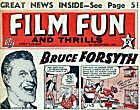


|
 |
|
| In
response to 'Judy', Fleetway introduced 'June' in 1961, containing some
sci-fi and espionage stories and also featuring Billy Bunter's sister Bessie
Bunter. 'June' merged with 'School Friend' in 1965. |

  |
| Black
and white print pages were used for stories based on other shows, but the
Dr Who 'Daleks' featured in colour on the back page. Doctor Who had already been featuring in TV Comic since 1964, but The Daleks had a separate copyright that allowing them to be used separately. |

  |
|
Pre
1960 |
Film
Fun: 17th January 1920 Adventure: 1921 Dandy: 4th December 1937 Radio Fun: 15th October 1938 (later Radio Fun and Adventures, c.1959) Eagle: 14th April 1950 Girl: 2nd November 1951 TV Comic: 9th November 1951 (expired 22nd June 1984) Topper: 7th February 1953 (expired 15th September 1990) Comic Cuts and Illustrated Chips: expired 1953 - replaced by TV Fun: 1953 (renamed TV Fan before its expiry in the late 50s) Robin: 28th March 1953 Jack and Jill: 27th February 1954 (expired 29th June 1985) Swift: 20th March 1954 Mirabelle: 10th September 1956 (expired 22nd October 1977) Valentine : 19th January 1957 (expired 9th November 1974) Romeo : 31st August 1957 (expired 14th September 1974) Roxy : 15th March 1958 |
    |
|
|
1960
|
30th
January: Princess comic
launched 28th May 'Buster' is introduced by Fleetway to rival D.C. Thomson's large size 'Topper' comic |
||
|
1961
|
Film
Fun is re-launched as Film Fun and Thrills
to expand its image beyond the mere 'humour' aspect Rover is merged with Adventure 18th February: British comic strip Radio Fun is merged into Buster 18th March - Bimbo comic is launched (expired 22nd January 1972) 25th February: Victor comic launched (expired 21st November 1992) |
||
|
1962
|
8th
September: Film Fun and Thrills comic expires 6th October: Valiant comic launched (ceased publication 3rd April 1971 following merger with TV21) |
||
|
1963
|
Diana
launched 19th January 1963: Treasure comic launched (expired 16th January 1972) 2nd March: Last individual editions of Eagle and Swift comics 9th March: Eagle and Swift comics merge 14th September: Roxy comic expires 14th September: Hornet comic launched (expired 7th February 1976) 21st September: Teddy Bear comic launched (expired 15th September 1973) |
||
|
1964
|
Look-In
is launched as a junior TV Times (expired 1984) 11th January: Jackie magazine launched (expired 3rd July 1993) 3rd October Girl comic expires October: Boy's World merges with Eagle after 40 editions |
||
|
1965
|
23rd
January: TV Century 21 (later TV21) comic is launched (merged
with Valiant 3rd April 1971) 23rd January: Sparky comic launched (expired 16th July 1977) |
||
|
1966
|
5th
February: Smash comic launched (expired 3rd April 1971) 24th September: Pippin comic launched (expired 26th September 1986) |
||
|
1967
|
The
Boys' Own Paper ceases publication 21st January: Mandy comic launched (expired 5th May 1991) 21st January: Pow! (and Wham!) comic launched 29th April: Giggle comic launched 16th September: Princess comic expires |
||
|
1968
|
13th
January: Giggle comic expires 27th January: Twinkle comic launched 27th April: JAG comic launched 7th September: Pow! (and Wham!) comic expires |
||
|
1969
|
TV21
merges with Joe 90 to become TV21 & Joe 90 25th January: Robin comic expires 26th April: Eagle and Swift comic expires April: JAG merges with Tiger 18th October: Whizzer and Chips comic launched (expired 27th October 1990) |
| On 20th March 2012, a number
of British comics were featured in a commemorative stamp issue by the
Royal Mail to celebrate the 75th Anniversary of 'Dandy', the world's longest
running comic. Each stamp pictured the 'star character' with their comic in the background. |
   |
|
|
All
Original Material Copyright SixtiesCity
Other individual owner copyrights may apply to Photographic Images |